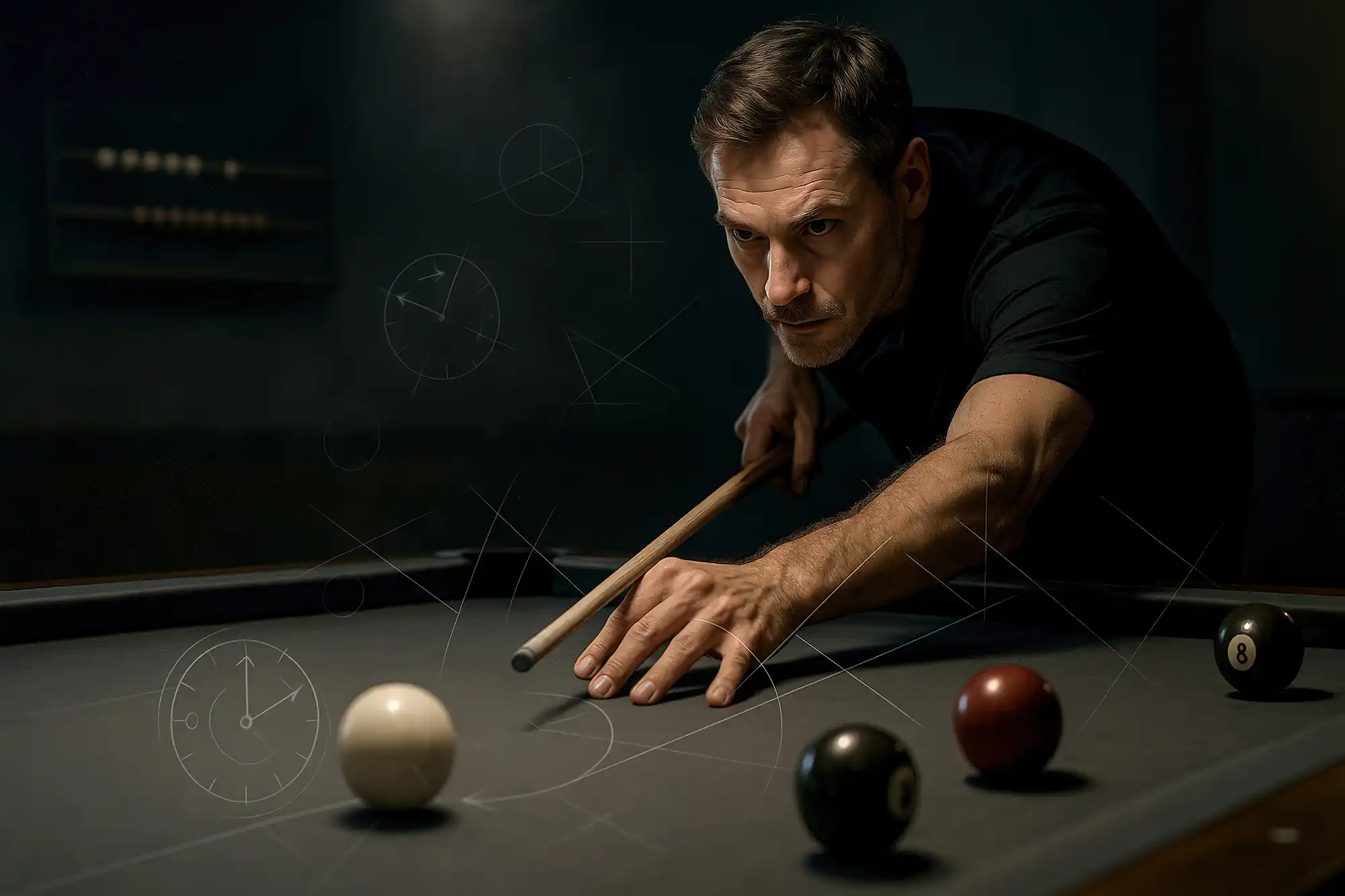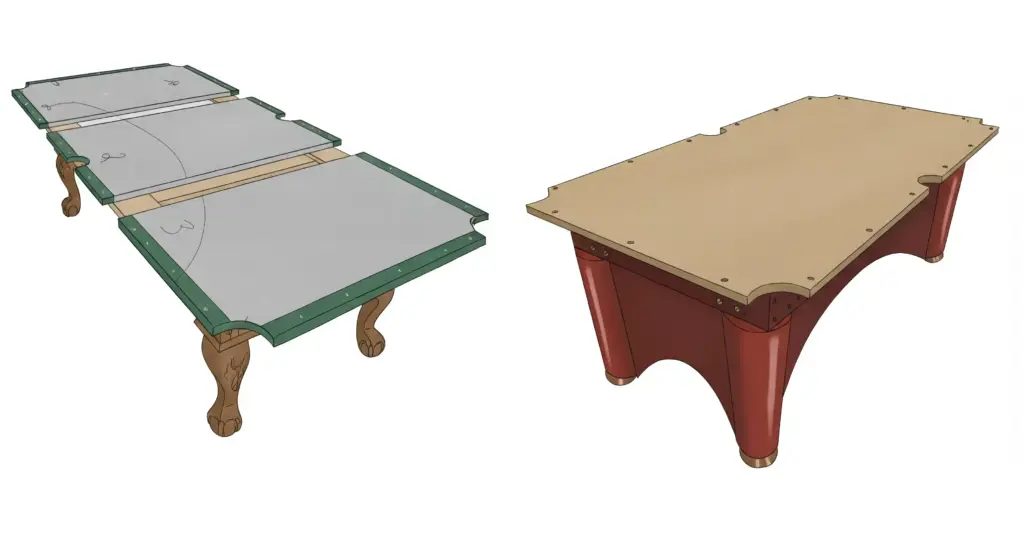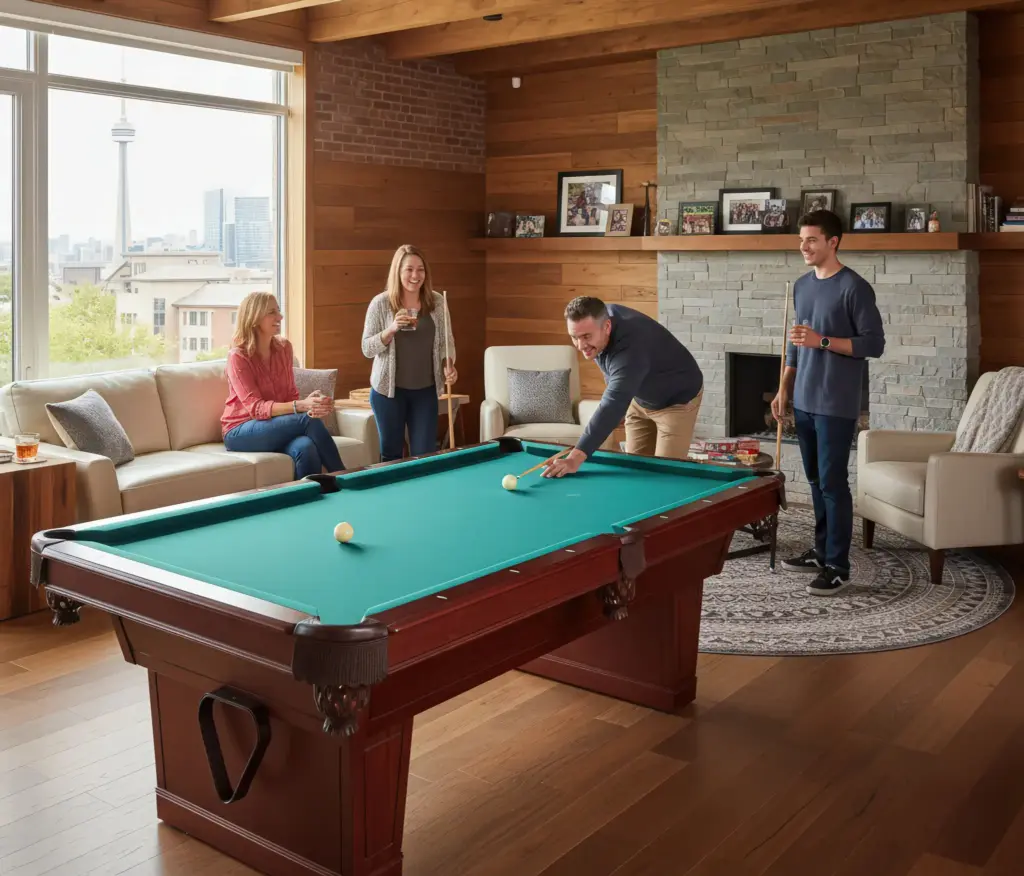The game of pool captivates with its blend of physics, finesse, and strategic thinking. Beyond simply hitting balls into pockets, a deeper world of techniques and tactics separates novices from skilled players. True proficiency demands more than a keen eye; it requires a comprehensive pool strategy, mastery of cue ball control, understanding various pool shot techniques, navigating different game rules, and dedicated practice. This guide delves into these essential areas, drawing insights from established knowledge to help enthusiasts elevate their game. Understanding the fundamentals of pool strategy is the first step towards controlling the table and outmaneuvering opponents, whether playing casually or in leagues across the GTA.
Introduction
Pool’s allure lies in both the satisfaction of a well-executed shot and the intellectual challenge of controlling the table. Many players hit a plateau, struggling to move beyond basic shot-making. The solution lies in developing a robust pool strategy encompassing fundamental techniques, advanced maneuvers, and game-specific tactics. This article explores the core elements necessary to improve your game, focusing on cue ball control, essential pool shot techniques, pool position play, and specific strategies for popular games like 8-ball and 9-ball, all based on proven principles.
Mastering Fundamental Pool Strategies: The Core of Your Game
A winning pool strategy starts with mastering the fundamentals. Control over the cue ball is paramount, dictating not just the current shot but also setting up future opportunities.
The Art of Cue Ball Control
Effective cue ball control hinges on mastering several key components, detailed below.
Table 1: Stance & Body Alignment
| Element | Position Detail | Benefit |
| Foot placement | Shoulders-width apart; weight 60/40 back foot | Stability & balance |
| Knee bend | Slight bend, no hunching | Lowers centre of gravity for steadiness |
| Head alignment | Directly over cue, forming straight line with body & cue | Consistent sight-line |
| Opposite foot orientation | Points slightly toward target | Natural body rotation |
| Consistency | Same stance every shot | Predictable cue-ball reaction |
Table 2: Pool Stroke Mechanics
| Stroke Element | Technique Detail | Common Pitfall | Tip for Consistency |
| Muscle use | Power from arm, not shoulders | Jerky shoulder thrust | Pause at bridge before forward stroke |
| Follow-through | Smooth acceleration through ball | Stopping too soon | Keep grip relaxed to allow natural follow-through |
| Power control | Calibrate force to shot’s distance | Over-jabbing/ lunging | Practice with progressively longer shots |
| Grip pressure | Light yet firm enough for control | Choking the cue | Find “just enough” pressure in warm-ups |
Table 3: Cue Ball Path Control
| Concept | Mechanics / Contact Point | Resulting Path / Effect | Practice Tip |
| Spin Techniques | – Topspin: strike 1/3 above center
– Backspin: 1/3 below – Sidespin: left/right of center |
– Follow through
– Draw back – Lateral deflection |
Use clock-face drill: visualize 12-, 6-, 3-, 9-o’clock hits |
| Speed Control | Vary stroke power to adjust cue-ball travel distance | – Alters travel length & interaction with spin | Do “stop-draw-follow” ladder drills at 5 distances |
| Tangent Line | Stun shot: strike center (no spin) | – Cue ball departs perpendicular to object-ball path | Practice stun shots into diamonds, plotting 90° departure |
Strategic Shot Planning and Visualization
Thinking ahead is key to a successful pool strategy. Pool position play involves setting up subsequent shots, not just pocketing the current one.
- Thinking Ahead: Plan one to three shots in advance.
- Visualization: Mentally picture the cue ball’s path before shooting. Focus on the exact contact point.
- Ghost Ball Technique: Imagine a phantom cue ball at the ideal contact point and aim to hit that spot.
- Using Diamonds: Rail markers aid in aligning bank and kick shots.
- Post-Shot Planning: After pocketing a ball, immediately assess the best position for the next shot.
Pattern Play Principles
- Keep the shot sequence simple; avoid excessive cue ball movement or spin.
- Leave angles on subsequent shots for better cue ball control options.
- Address problem balls (clusters, frozen balls) early.
- Pocket balls in logical groups to minimize table travel (especially in 8-ball strategy).
- Work backward from the game-winning ball (e.g., the 8-ball) when planning a run-out.
- Identify key balls that help gain position on critical shots.
Expanding Your Arsenal: Essential Pool Shot Techniques
Mastering fundamental pool shot techniques builds the foundation for more complex play.
The Precise Straight Shot
This fundamental shot requires hitting the cue ball’s center to propel the object ball straight into the pocket.
- Execution: Aim for the cue ball’s center. Force varies with distance.
- Stop Shots: May require stopping the cue stick upon contact, avoiding follow-through. Hitting below center with sufficient speed is needed for distance stop shots.
- Aiming: Use the “ghost ball” method (imagine the object ball as the ghost ball, aim full).
- Common Errors: Poor cue delivery, unintentional side spin (“vertical axis perception error”). Adjusting head height might help.
- Practice: Drills involving shooting into a specific point in the pocket or bouncing the cue ball off rails back to the tip help eliminate unwanted spin.
The Calculated Cut Shot
Used when the object ball isn’t in a direct line to the pocket, requiring an angled shot.
- Execution: Requires understanding the angle and precise contact point on the object ball.
- Back Cuts: Sometimes “aiming to miss” slightly, often using spin, is effective.
- Using Spin: Spin can alter the object ball’s path (e.g., left spin can make an object ball cut slightly more left).
- Practice: Start with straight shots, gradually increasing the cut angle. Practice first with a rolling cue ball (no spin), then experiment with different spins. A consistent stroke is vital.
The Strategic Bank Shot
Involves bouncing the object ball off one or more rails into a pocket.
- Execution: Requires visualizing the rebound angle off the cushion.
- Physics: Angle of incidence equals angle of reflection (without spin, high speed).
- Speed Influence: Faster speed = shorter rebound; slower speed = longer rebound.
- Spin Influence: Spin transfers to the object ball (in the opposite direction), affecting rebound (backspin shortens the bank, topspin lengthens it).
- Aiming Systems: “Parallel shifting” and the diamond system can aid aiming.
- Practice: Developing an instinctive feel through repetition is key.
- Types: Straight banks vs. inside-out banks.
- Avoiding Double Kisses: Be aware of scenarios where the object ball might hit the cue ball after rebounding from the rail.
- Defensive Use: Can be used to play safe.
Advanced Pool Shots: Unlocking Complex Techniques
Mastering advanced pool shots adds significant depth to your pool strategy.
The Curving Masse Shot
Curves the cue ball around obstacles using high cue elevation and maximum spin.
- Execution: Elevate cue stick steeply (>45 degrees), apply significant sidespin (often combined with top/bottom spin). Visualize the curved path.
- Semi-Masse: Less dramatic curve using ~45-degree elevation and sidespin.
- Spin Application: Use the “clock face” (9 o’clock for left curve, 3 o’clock for right curve, 6 o’clock for backward curve).
- Applications: Getting around blockers, playing safe, escaping hooks, altering post-collision cue ball direction.
- Caution: Practice responsibly to avoid damaging the table cloth.
The Aerial Jump Shot
Elevates the cue ball over an obstructing ball.
- Execution: Use a specialized jump cue (recommended). Elevate cue significantly (40-50+ degrees). Strike slightly below center with a quick, downward “poke” or “punch” stroke.
- Technique: Stable stance, weight forward, relaxed grip and wrist. Focus on hitting slightly below an imaginary “pearl” at the cue ball’s center.
- Practice: Practice over obstacles of increasing height. Controlled force is key, not excessive power.
- Applications: Clearing blocking balls to pocket a target or gain position.
- Common Errors: Improper cue angle, too much force, not hitting low enough.
The Intricate Combination Shot
Uses one object ball to pocket another.
- Execution: Think in reverse. Determine the contact point needed on the second ball to pocket it. Visualize the first ball hitting that point. Aim the cue ball to make the first ball strike the second ball correctly.
- Risk vs. Reward: Evaluate if a direct shot is easier. Assess if the combo offers better cue ball position. Difficulty increases with distance between balls and angle.
- Applications: Pocketing blocked balls, breaking clusters, achieving better position.
Navigating Game Variations: 8-Ball and 9-Ball Strategy
Different pool games require distinct strategic approaches. Understanding the nuances of 8-ball strategy and 9-ball strategy is crucial for players in Toronto and beyond.
The Tactical Game of 8-Ball: Offense, Defense, Key Considerations
8-ball strategy involves pocketing your group (solids or stripes) and then the 8-ball.
Offensive Tactics (8-Ball Strategy)
- Choose your group wisely after the break.
- Plan the entire run-out, often working backward from the 8-ball.
- Minimize cue ball movement; use controlled pool position play.
- Clear center-table balls early.
- Break out clusters when you have an “insurance” ball.
- Pocket balls in logical groups.
- Address problem balls early.
- Don’t attempt a run-out without a clear plan.
- Utilize key balls for position on the 8-ball.
Defensive Tactics (8-Ball Strategy)
- Play safe early if a run-out isn’t clear.
- Create problems for the opponent (block pockets, leave difficult shots).
- Consider intentional fouls (pocketing opponent’s problem ball) in tough spots if they don’t have an easy run-out.
- Leave your balls near pockets as blockers.
- Safeties can involve hiding the object ball or cue ball, or creating distance.
- Strategic safeties are often better than low-percentage offensive attempts.
Common 8-Ball Scenarios
- Break strategies often involve hitting the lead ball slightly off-center to pocket second-row balls.
- Dealing with clusters requires planning.
- Use ball-in-hand effectively for offense or defense.
- Avoid common losing mistakes (pocketing 8-ball early, scratching on 8-ball).
The Dynamic Game of 9-Ball: Rotation, Position, Winning Shots
9-ball strategy focuses on pocketing balls in numerical order (1-9), hitting the lowest-numbered ball first on each shot. The 9-ball can be pocketed legally at any time to win.
Offensive Tactics (9-Ball Strategy)
- Emphasis on precise cue ball control for position on the next ball in sequence.
- Bank and combination shots are valuable for pocketing balls (including the 9-ball) and navigating layouts.
- Pattern selection is about choosing advantageous angles and positions, not just order.
- Aim to get the cue ball close to the next numbered ball. Aim for center table if unsure.
- Proficiency in long shots is important.
- Practice specialty shots (banks, combos, caroms, kicks, jumps, curves).
- Look for “two-way” shots (offensive chance + defensive leave if missed).
- Effective breaks aim to pocket the 1-ball or wing ball, potentially the 9-ball.
- Plan shots in groups of three (current ball, next ball, ball after next).
Defensive Tactics (9-Ball Strategy)
- Play safe if pocketing the legal ball is unlikely.
- Leave the cue ball and object ball far apart.
- Try to bury the next ball or cue ball.
- Utilize the push-out rule strategically after the break.
- Avoid leaving easy shots (“hangers”).
- Softly roll cue ball to a short rail or tap an object ball to leave a difficult kick shot.
Common 9-Ball Scenarios
- Effective breaking is crucial.
- Understand push-out strategy.
- Address challenging positions involving the lowest ball.
- Recognize combination opportunities, especially on the 9-ball.
The Roadmap to Improvement: Effective Pool Practice Drills
Consistent, focused practice is essential for improving your pool strategy and execution.
Developing Consistency: Essential Practice Routines
- Focus on Fundamentals: Regularly practice stance, grip, and stroke.
- Pre-Shot Routine: Develop a consistent routine (analyze, visualize, aim, stance, pause, practice strokes, shoot, follow-through).
- Cue Swing Practice: Focus on a smooth pendulum motion.
- Bridge Practice: Work on both open and closed bridges.
- Track Progress: Record sessions, note improvements and areas needing work.
- Structured Practice: Challenge yourself (run racks, play straight pool).
- Practice with Purpose: Focus on specific skills or weaknesses. Avoid sloppy practice. Take breaks.
Enhancing Cue Ball Control Through Targeted Drills
- Center Ball Drills: Develop accurate contact.
- Rolling Shot Drills: Understand cue ball reaction at different speeds/angles.
- Stun Shot Drills: Master stop shots, sliding cue ball, stun draw/follow.
- Maximum High Drills: Develop follow shot control.
- Half-Table Pattern Play: Practice position within limited space.
- Wagon Wheel Drills: Improve position control around the table.
- Line-of-Balls Drills: Practice stop, follow, draw on sequential balls.
- Leaving Angles Drills: Maximize subsequent shot options.
- “Mafi” Drill: Shoot cue ball up/down table, returning straight to the tip (for straightness).
- Fixed Cue Ball Drills: Target different object balls from one spot to understand angles.
Sharpening Shot Accuracy with Specific Exercises
- Straight Shot Practice: Vary distances.
- Stop Shot Repetition: Gauge stroke accuracy and unintentional spin.
- Follow Shot Drills: Develop topspin feel and control.
- Draw Shot Drills: Master backspin technique.
- Corner-to-Corner Drills: Reinforce straight stroke over distance.
- Line of Stop Shots: Pocket a line of balls with stop shots on each.
- Diagonal Long Shot Drills: Test stop, follow, draw accuracy on challenging shots.
- Elevated Cue Shot Practice: Develop precision for clearing obstacles.
- Positional Accuracy Drills: Stop cue ball within defined areas after pocketing.
Avoiding Common Pitfalls: Identifying and Correcting Mistakes
Recognizing common errors is crucial for improving your pool strategy and overall game.
Fundamental Errors in Technique and Approach
- Insufficient Chalking: Leads to miscues.
- Raising/Lowering Cue: Keep cue level during the stroke.
- Inconsistent Stance: Creates instability.
- Weak/Unstable Bridge: Reduces accuracy.
- Taking Eyes Off Cue Ball: Disrupts focus and aim.
- Inappropriate Cue Weight/Length: Hinders performance.
- Gripping Cue Too Tightly: Restricts smooth stroke.
- Unnecessary Head/Body Movement: Affects accuracy.
- Aiming After Getting Down: Aim before settling into the stance.
- Excessive Force: Leads to loss of control and missed shots.
- Overusing Sidespin: Decreases accuracy when not needed.
- Choosing Draw Over Follow: Opting for a more complex shot unnecessarily.
- Lack of Planning/Pattern: Leads to difficult positions.
Mistakes in Advanced Shots and Strategic Decisions
- Attempting Advanced Shots Without Proper Technique: Leads to miscues, scratches, fouls (e.g., jump ball off table).
- Misjudging Masse Curve: Incorrect spin or elevation.
- Misjudging Combination Angles/Contact: Leads to misses.
- Taking Low-Percentage Shots: Choosing risky shots over safer options.
- Misusing Ball-in-Hand: Failing to address problems or plan sequence.
- Ignoring Defensive Opportunities: Always opting for difficult offense.
- Not Adapting Strategy to Game Type: Using 8-ball tactics in 9-ball, etc.
- Saving Problem Balls (8-Ball): Leaving difficult shots until the end.
- Leaving Cue Ball Straight-In: Limits positional options for the next shot.
The Influence of Equipment and Environment
While skill is paramount, equipment and table conditions affect performance. Choosing the right gear can significantly impact your game.
Selecting the Right Cue
- Weight: Affects control vs. power (lighter = more control, heavier = more power). Standard: 18-21 oz. Test different weights.
- Balance: Find a cue that feels comfortable.
- Length: Standard 58-inch cue suits most adults (5’8″ to 6’5″).
- Tip Hardness: Softer = more control/spin; Harder = more power/durability. Medium is often good for beginners.
- Maintenance: Frequent chalking is essential.
- Explore our wide selection of pool cues to find the perfect fit for your style.
Understanding Table Conditions
- Levelness: Crucial for accurate ball roll. Uneven surfaces cause deviation.
- Cloth (Felt): Affects speed and spin (Faster cloth = less friction/spin; Slower = more control). Condition (worn/dirty) impacts consistency.
- Rails (Cushions): Affect rebound angles (“short” vs. “long” rails).
- Pockets: Tighter pockets demand more accuracy.
- Balls: Worn/dirty balls roll less predictably.
- Adaptation: Experienced players adjust their pool strategy based on table conditions. Warm up on the table before playing.
FAQ
What is the most important aspect of pool strategy?
- Mastering cue ball control through proper stance, stroke, spin, and speed is arguably the most critical foundation for any effective pool strategy, as it dictates pool position play for subsequent shots.
How can I improve my aiming in pool?
- Consistent practice focusing on a stable stance, smooth stroke, and techniques like the “ghost ball” method are key. Drills specifically designed for straight shots and cut shots at various angles will also significantly improve accuracy.
When should I use English (sidespin)?
- Use English strategically to alter the cue ball’s path after hitting an object ball or rail, primarily for achieving better position or navigating around obstacles. Avoid using it unnecessarily, as it can decrease accuracy on simpler pool shot techniques.
What’s the main difference between 8-ball strategy and 9-ball strategy?
- 8-ball strategy focuses on clearing your designated group (solids or stripes) and planning a run-out culminating in pocketing the 8-ball, often involving defensive play. 9-ball strategy emphasizes pocketing balls in numerical order (hitting the lowest first), with a heavy focus on precise pool position play for the next ball in sequence, as the 9-ball can win the game at any time.
Conclusion
Developing proficiency in pool is a journey requiring dedication to understanding pool strategy, mastering fundamental pool shot techniques, and consistent practice using effective pool practice drills. From the basics of cue ball control and stance to the complexities of advanced pool shots like masse and jump shots, and navigating the specific tactics of 8-ball strategy and 9-ball strategy, continuous learning is key. Recognizing common mistakes and understanding how equipment and table conditions influence play further refines your approach. By applying the principles discussed, players can significantly improve their game and enjoy the strategic depth pool offers.
For expert advice on pool tables, accessories, and improving your game in the Toronto area, contact Hallmark Billiards today or visit our showroom in Mississauga.





